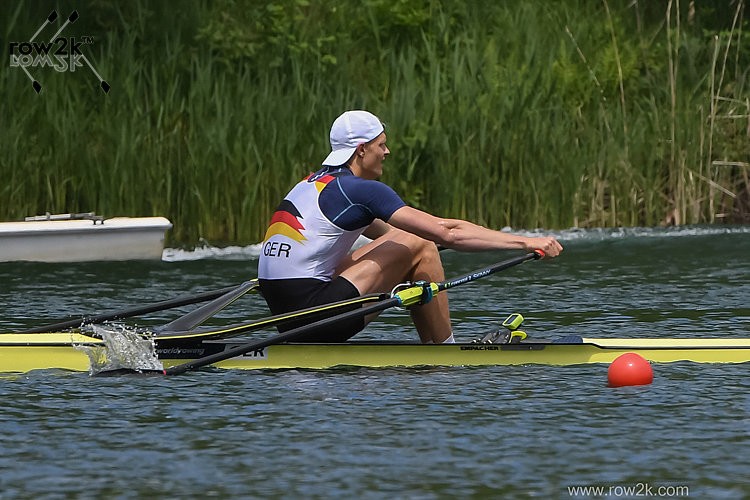
Many rowers appreciate that a rowing shell does not move at a constant speed throughout the stroke – it surges and settles. I would hazard to guess though, that most beginners and perhaps even some more experienced rowers, imagine that the boat surges from the catch to the finish and then slows down from the finish to the catch. It doesn't quite work that way.
One of the basic rules of physics is that every action has an equal and opposite reaction. So imagine 8 150 lb rowers coming to the catch at once, that's 1200 lbs. As they change direction from the recovery (towards the stern) to the drive (towards the bow), the boat wants to go in the opposite direction. Fortunately, this rule of physics then works for us at the release. When those eight bodies change direction from the drive to the recovery, that 1200 lbs moving towards the stern helps send the boat in the opposite direction, towards the finish line. We are powering the boat on the recovery, propelling the boat to its maximum speed about half way up the slide.

So as we go from a year of not racing to now training for sprint races, it's important that we keep this law of physics in mind. When we start training more intensely, we tend to make the entire stroke harder – hard catch, hard drive, hard finish. What we coach is making the catch light, keeping as much pressure off the foot stretcher until you can get pressure on the blade. While you won't be able to eliminate check, you can significantly reduce it. At the finish, we coach cutting the pressure just before releasing the blade from the water and making the feather the beginning of the recovery, not the end of the drive.

How best to work on this? One exercise I promote for a variety of reasons is getting in the habit of starting from the catch position whenever you're starting from a dead stop. Don't kick the legs down but rather squeeze them until you feel a little pressure on the face of the blade and then you can accelerate. The drive should be smooth. Now try and make every stroke feel the same – catch first, then drive.
Another drill is the finish to catch drill. Sit at the finish, blades squared and mostly buried. From here, move to the catch and stop – our mantra is body-slide-catch. No drive. With less weight on the foot stretcher, there is less check. This drill can help your release as well. Every part of this drill should be considered part of the recovery – the release all the way up to the catch. Because there is no drive, there should be no motion from the stern to the bow. Once the blade is in, you stop. We're trying to emphasize the difference between the catch and the drive. While I don't do a lot of stationary drills, I will incorporate this drill into my rowing by trying to separate the catch from the drive.

To work more specifically on the finish, you can truncate the above drill. Sit at the finish again, with the blade squared and mostly buried. From here, we want to tap down on the oar handle while feathering the blade and while moving the hands and body out of bow – all three motions combined. I imagine my hands are going down a slide – as I am pushing the oar handle down, I am also feathering and all the while my hands and body move out of bow. Stop at quarter slide or so and come back to the finish to try again. This drill is how we conceptualize making the feather the beginning of the recovery. Remember, as we move the weight of the body out of bow, the boat surges in the opposite direction.

With lighter catches, smoother drives and cleaner finishes, not only will you go faster but you'll feel you're rowing more easily. More speed with less work, just in time for racing!
If you enjoy and rely on row2k, we need your help to be able to keep doing all this. Though row2k sometimes looks like a big, outside-funded operation, it mainly runs on enthusiasm and grit. Help us keep it coming, thank you! Learn more.
Comments | Log in to comment |
There are no Comments yet
| |
- Bont Rowing
- Calm Waters Rowing
- Concept 2
- Craftsbury Sculling
- The Crew Classic
- CrewLAB
- Croker
- Durham Boat Co.
- Empacher
- Faster Masters
- Filippi
- Fluidesign
- h2row.net
- HUDSON
- Live2Row Studios
- Nielsen-Kellerman
- Oak Ridge RA
- Peinert Boat Works
- Pocock Racing Shells
- Race1 USA
- RowKraft
- Rubini Jewelers
- Vespoli USA
- WinTech Racing
- Bont Rowing
- Calm Waters Rowing
- Concept 2
- Craftsbury Sculling
- The Crew Classic
- CrewLAB
- Croker
- Durham Boat Co.
- Empacher
- Faster Masters
- Filippi
- Fluidesign
- h2row.net
- HUDSON
- Live2Row Studios
- Nielsen-Kellerman
- Oak Ridge RA
- Peinert Boat Works
- Pocock Racing Shells
- Race1 USA
- RowKraft
- Rubini Jewelers
- Vespoli USA
- WinTech Racing

















